Unleash the Best: The Ultimate Guide to Dog Toys for Aggressive Chewers
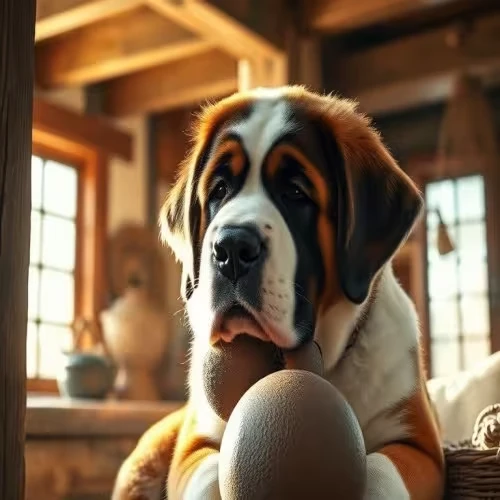
For owners of power chewers, the quest for the perfect, durable dog toy can feel like an unending odyssey. Your beloved canine companion, despite their gentle demeanor, possesses jaws capable of dismantling even the toughest toys in mere minutes, leaving behind a trail of shredded material and a frustrated sigh. But the search for the Holy Grail of dog toys for aggressive chewers doesn't have to be a battle lost. This comprehensive, data-driven guide is meticulously crafted to help you navigate the vast market of durable dog chew toys for large dogs, ensuring you find truly indestructible dog toys for heavy chewers and robust chew toys for strong dogs. Our goal is to empower you with the knowledge to make informed decisions, keeping your canine companion entertained, engaged, and most importantly, safe.
Understanding Your Dog's Chewing Habits
Before embarking on the journey of selecting the ideal toy, it's paramount to understand the underlying reasons behind your dog's aggressive chewing. Chewing is a natural canine behavior, but its intensity can vary greatly. Is it a symptom of boredom, a coping mechanism for anxiety, the discomfort of teething, or simply an innate urge inherent to their breed? Identifying the root cause is the first step toward choosing toys that not only withstand their powerful jaws but also address their specific needs more effectively. For instance, a dog chewing out of boredom might benefit more from a puzzle-dispensing toy than a solid, unengaging block of rubber. If the chewing behavior is excessive, sudden, or destructive beyond typical limits, always consult your veterinarian to rule out any underlying medical conditions or dental issues that might be contributing to the behavior.
Best Dog Toys for Aggressive Chewers: Types and Materials
The market is saturated with toys boldly proclaiming their indestructibility, yet the reality often falls short when faced with a truly determined chewer. However, certain materials and innovative designs stand head and shoulders above the rest in terms of durability. Here’s a detailed breakdown of the most effective types and materials:
1. Durable Rubber Toys: The Resilient Standard
High-quality, thick rubber toys are often the first line of defense against aggressive chewing. While no toy is truly indestructible, premium natural rubber compounds offer significant resistance for many power chewers. Look for toys made from dense, natural rubber or those reinforced with extra layers for enhanced durability. Brands like Kong and West Paw have built their reputation on this foundation. These toys often come in a myriad of shapes and sizes, many featuring interactive elements such as treat-dispensing capabilities, which add an extra layer of mental stimulation.
- Pros: Generally affordable, widely available, excellent for interactive play, many are treat-dispensing for added engagement. Natural rubber is often non-toxic and resilient.
- Cons: Even the most durable rubber can eventually succumb to persistent, strong chewers. Requires vigilant supervision and timely replacement to prevent the ingestion of small, worn-off pieces.
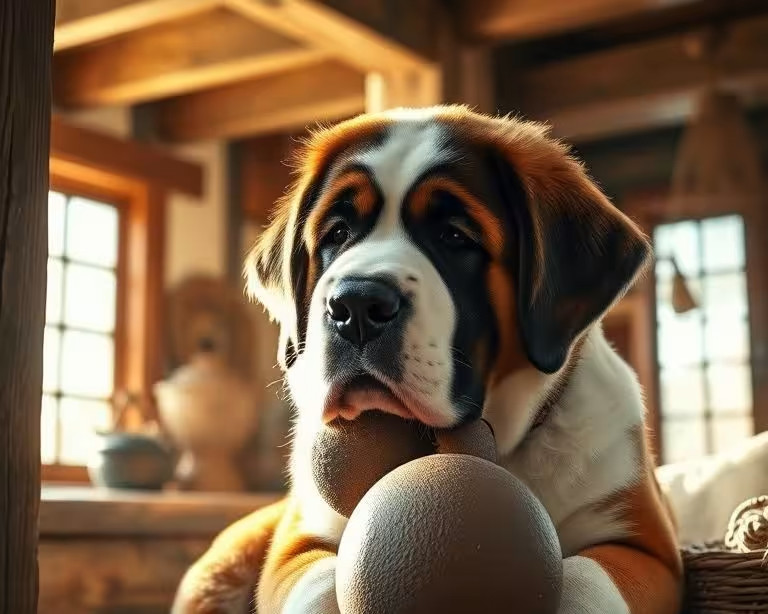
2. Indestructible Dog Toys for Heavy Chewers: Nylon and Other Synthetics
Many specialized chew toys are crafted from extremely tough nylon or other advanced synthetic polymers specifically engineered to withstand the most powerful jaws. These materials are often molded into shapes designed for maximum durability and oral stimulation. Nylabone's DuraChew line and Benebone's flavored nylon toys are prime examples. These can be an excellent option for dogs who enjoy the sensation of tearing and grinding, as the hard material can satisfy their urge while also helping to clean teeth and massage gums. When selecting, prioritize toys without small, detachable components that could pose a choking hazard.
- Pros: Exceptional toughness and resistance to aggressive chewing, often designed with dental health benefits (e.g., textured surfaces). Available in various shapes, sizes, and even flavors.
- Cons: Can be more expensive than rubber toys. Some dogs may find them less engaging due if they prefer a softer texture. Hard materials, if chewed aggressively, can sometimes cause wear on teeth, so supervision and moderation are key.
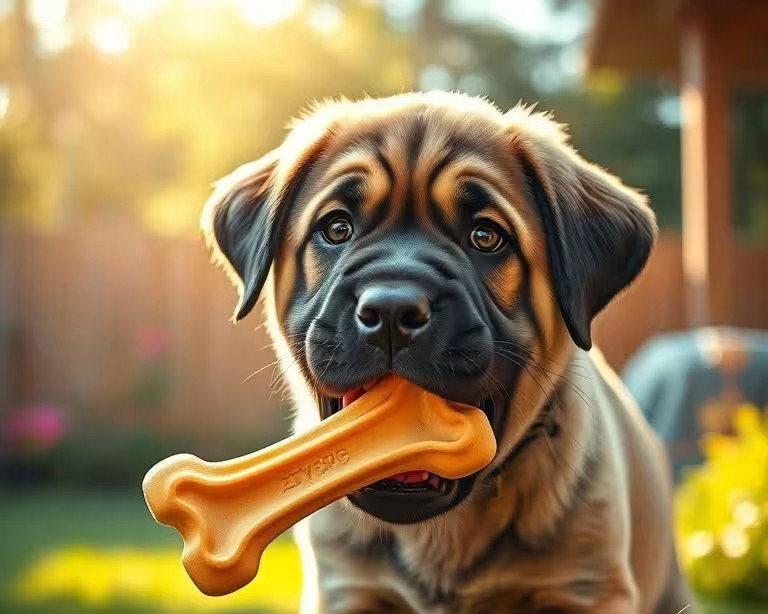
3. Heavy-Duty Dog Toys for Powerful Chewers: Reinforced Fabrics and Specialty Designs
For the truly relentless chewers, some manufacturers have turned to industrial-grade materials and multi-layered construction. This category includes toys made from ballistic nylon, firehose material, or proprietary composite materials that combine extreme strength with a degree of flexibility. Brands like GoughNuts specialize in designs engineered specifically for safety and durability, often featuring a 'safety indicator' core that reveals a different color if the outer layer has been compromised. These toys are specifically engineered to resist aggressive chewing for extended periods, but constant supervision remains crucial to ensure no parts come loose or are ingested.
- Pros: Unparalleled durability designed for the most powerful chewers. Often made with safety features in mind.
- Cons: Can be significantly more costly. The variety of shapes and interactive features might be more limited compared to rubber toys.
4. Chew Toys for Strong Dogs: The Rope Toy Dilemma (with Caution)
Rope toys, with their tactile texture and suitability for tug-of-war, are immensely appealing to many dogs. However, for aggressive chewers, most standard rope toys pose a significant hazard. They unravel quickly, leading to strands that can be ingested, causing choking or serious internal blockages. If you choose to offer rope toys, extreme caution and strict selection criteria are necessary. Opt for rope toys made from thick, tightly braided natural fibers like hemp or dense cotton, specifically marketed for heavy chewers. Even then, continuous, direct supervision is non-negotiable, and any sign of fraying warrants immediate disposal.
- Pros: Excellent for interactive tug-of-war games, can offer good oral stimulation when used correctly.
- Cons: High risk of unraveling, posing severe choking and obstruction hazards if not meticulously selected and constantly supervised. Not recommended for unsupervised play with aggressive chewers.
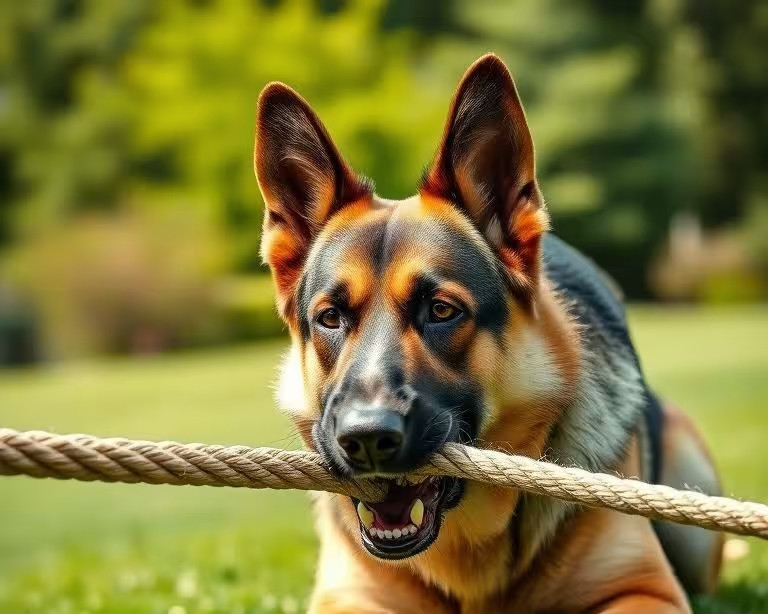
Top Recommendations: A Data-Driven Comparison for Durable Dog Chew Toys for Large Dogs
Here, we delve into specific brands and models that consistently receive high praise from owners of power chewers. This comparison provides factual data points to help you make an informed decision, understanding that even the most robust toys may eventually meet their match. Remember, safety and monitoring are always paramount.
1. Kong Extreme
- Material Composition: Proprietary KONG Extreme natural rubber compound, specifically formulated for the toughest chewers.
- Durability Rating: 9.5/10 (Among the highest for rubber toys).
- Average Price Range: $15 - $30 (depending on size).
- Key Features: Stuffable design for mental enrichment, irregular bounce for engaging play, non-toxic, dishwasher safe.
- Pros: Exceptionally durable, provides mental stimulation when filled with treats, versatile for fetch and chew sessions, widely available.
- Cons: Can be messy when stuffed, some dogs may eventually wear them down over extended periods.
2. Nylabone DuraChew
- Material Composition: Durable, food-grade nylon, often infused with flavors (e.g., bacon, chicken).
- Durability Rating: 8.5/10 (Excellent for strong chewers, but can show wear).
- Average Price Range: $8 - $20 (depending on size and shape).
- Key Features: Textured surfaces help clean teeth and control plaque/tartar, various shapes (e.g., bone, wishbone, ring) to suit different chewing styles.
- Pros: Promotes dental health, long-lasting for many chewers, flavored options enhance appeal, relatively affordable.
- Cons: Can be very hard, potentially causing tooth wear if a dog chews too aggressively or has pre-existing dental issues. Small pieces can break off if severely damaged, requiring replacement.
3. West Paw Zogoflex Tux
- Material Composition: Proprietary Zogoflex material (a blend of plastic and rubber), non-toxic, BPA-free, phthalate-free, FDA compliant.
- Durability Rating: 9/10 (Highly resilient and flexible).
- Average Price Range: $18 - $35 (depending on size).
- Key Features: Stuffable, floats, dishwasher safe, recyclable, made in the USA. Unique 'cup' design holds treats securely.
- Pros: Very durable yet flexible, excellent for both chewing and fetching, eco-friendly, bright colors make it easy to spot, comes with a manufacturer's guarantee.
- Cons: Can be a bit pricier than basic rubber toys, some dogs might find the material less appealing than natural rubber.
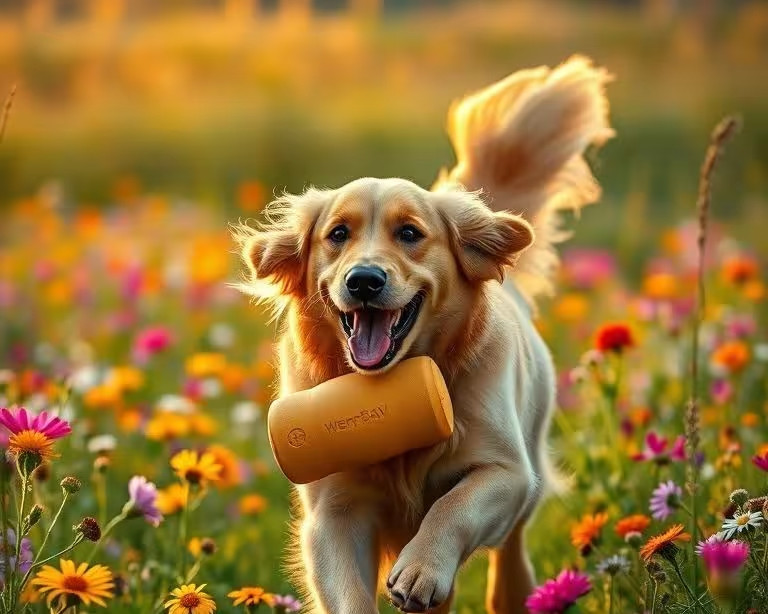
4. Benebone Wishbone
- Material Composition: Durable, food-grade nylon, infused with 100% real ingredients like bacon, chicken, or peanut butter.
- Durability Rating: 8.8/10 (Very tough, but can develop sharp edges).
- Average Price Range: $10 - $25 (depending on size).
- Key Features: Ergonomic wishbone shape for easy grip, deep flavor infusion throughout the toy, made in the USA.
- Pros: Highly appealing due to real flavor infusion, excellent for dental hygiene, very robust for heavy chewers, unique shape makes it easy for dogs to hold.
- Cons: Similar to Nylabone, the hard material can be tough on teeth. Can become sharp after extensive chewing, requiring inspection and sanding or replacement.
5. GoughNuts Ring
- Material Composition: Multi-layered, proprietary natural rubber composite, engineered for extreme durability.
- Durability Rating: 9.8/10 (Among the highest for truly aggressive chewers).
- Average Price Range: $25 - $50 (depending on size and model).
- Key Features: Patented 'safety indicator' (red core visible if outer layer is breached), virtually indestructible design, floats, made in the USA.
- Pros: The pinnacle of durability for many aggressive chewers, excellent safety feature, designed by mechanical engineers, often comes with a replacement guarantee.
- Cons: Higher price point, limited in terms of interactive features beyond chewing, very dense and heavy.
Beyond Toys: Addressing the Root Causes of Aggressive Chewing
While providing the best dog toys for aggressive chewers is essential, it's only one piece of the puzzle. For truly effective management, it's crucial to address the underlying reasons behind your dog's intense chewing:
1. Boredom & Lack of Stimulation
A significant portion of destructive chewing stems from a lack of adequate physical and mental exercise. Dogs, especially high-energy breeds, need outlets for their energy. Ensure your dog receives regular, vigorous walks, runs, and interactive playtime. Incorporate mental stimulation through puzzle toys, obedience training, scent work, or agility. A tired dog is often a well-behaved dog.
2. Anxiety & Stress
Chewing is a self-soothing behavior for many dogs, and aggressive chewing can be a symptom of anxiety, such as separation anxiety, fear, or generalized stress. If you suspect anxiety is a factor, observe your dog's behavior for other signs like pacing, excessive drooling, destructive behavior when left alone, or changes in appetite. Consulting a veterinarian or a certified professional dog trainer specializing in behavior can provide tailored strategies, which may include counter-conditioning, desensitization, or in some cases, medication.
3. Teething & Oral Health
For puppies, chewing is a natural and necessary part of the teething process, helping to alleviate discomfort as adult teeth emerge. Providing a variety of appropriate, safe chew toys during this period is crucial. For adult dogs, chewing can also be a way to maintain oral hygiene, removing plaque and tartar. However, if chewing is causing damage to teeth or gums, or if your dog seems to be in pain, a vet check is essential to rule out dental disease or injuries.
Safety First: Essential Practices for Aggressive Chewers
Regardless of how 'indestructible' a toy claims to be, vigilant safety practices are non-negotiable for aggressive chewers. Your dog's well-being should always be the top priority:
- Regular Inspection: Make it a habit to examine all of your dog's toys daily for signs of wear, cracks, tears, or loose pieces.
- Timely Replacement: Any toy showing significant damage, no matter how minor, should be immediately discarded and replaced. Small ingested pieces can cause choking or serious internal blockages.
- Appropriate Sizing: Always choose toys that are appropriately sized for your dog's breed and jaw strength. A toy that is too small can easily become a choking hazard.
- Supervision: Never leave an aggressive chewer unsupervised with a new or potentially questionable toy. Even familiar toys should be monitored, especially if your dog is known to destroy things quickly.
- Avoid Dangerous Materials: Steer clear of toys made with easily shreddable materials, soft plastics, or those with small, glued-on parts.
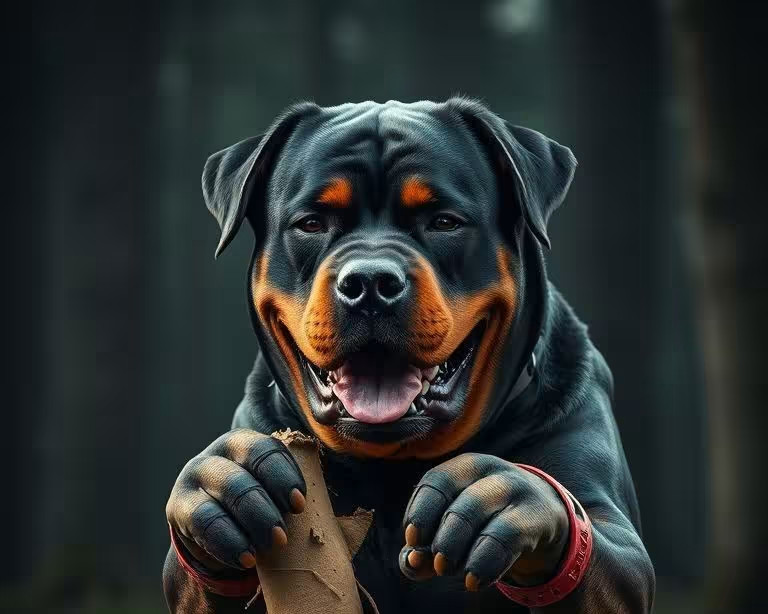
Frequently Asked Questions (FAQ) about Aggressive Chewer Toys
Q: What makes a dog toy 'indestructible'?
A: The term 'indestructible' is often used loosely in marketing. In reality, no dog toy is truly 100% indestructible against a determined power chewer. What makes a toy highly durable is its material composition (e.g., high-grade natural rubber, dense nylon, proprietary composites), its design (solid construction, no weak points), and its manufacturing quality. These toys are engineered to withstand extreme force and prolonged chewing, significantly outlasting standard toys, but they still require regular inspection and replacement.
Q: How often should I replace aggressive chewer toys?
A: There's no fixed schedule, as it depends on your dog's chewing intensity and the toy's material. The rule of thumb is to replace a toy immediately once it shows any significant signs of wear and tear, such as cracks, loose pieces, sharp edges, or if its integrity is compromised. Regular daily inspection is key to ensuring safety.
Q: Are natural chew toys (like antlers or real bones) safe for power chewers?
A: While natural, items like antlers, hooves, and real bones can pose significant risks for aggressive chewers. They are often too hard and can cause fractured teeth, painful gum injuries, or splinters that can lead to internal damage or blockages. Always consult your veterinarian before offering natural chews, and opt for safer, veterinarian-approved alternatives if your dog is a very strong chewer.
Q: Can aggressive chewing be a sign of a problem?
A: Yes, excessive or sudden aggressive chewing can indeed be a symptom of underlying issues. These can include boredom, lack of mental or physical stimulation, separation anxiety, stress, or even dental pain. If you notice a significant change in your dog's chewing habits or if it becomes destructive, it's advisable to consult your vet or a certified professional dog trainer to identify and address the root cause.
Q: What's the best way to introduce a new toy to an aggressive chewer?
A: Introduce new toys under supervision. Observe how your dog interacts with it. If it's a treat-dispensing toy, initially make it easy to get treats out to build positive association. For solid chew toys, ensure it's appropriately sized and doesn't pose an immediate choking hazard. Always supervise the first few play sessions to gauge its durability against your dog's specific chewing style.
Q: How can I tell if a toy is too hard for my dog's teeth?
A: A simple test is the 'thumbnail test.' If you can't indent the toy with your thumbnail, it's likely too hard for your dog's teeth and could cause dental damage. Also, listen for loud cracking sounds when your dog chews; this can indicate excessive force that might be harming their teeth. Opt for toys with some give but still offer resistance.
Q: Are there any toys that are truly 100% indestructible?
A: No, the concept of a 100% indestructible dog toy is a myth. Even the toughest materials can eventually be broken down by a powerful, persistent chewer. The goal is to find the most durable options that last a reasonable amount of time and are designed with safety in mind, requiring regular inspection and replacement.
Q: What are some alternatives to traditional chew toys for strong chewers?
A: Beyond the recommended durable toys, consider enrichment activities that satisfy the chewing instinct without solely relying on traditional toys. This includes interactive puzzle feeders filled with kibble or safe treats, frozen Kongs, supervised raw meaty bones (if vet-approved and appropriate for your dog), or even specific training exercises that engage their jaws in a controlled manner.
Conclusion: Finding the Perfect Fit for Your Powerful Chewer
The journey to finding the ideal toys for your aggressive chewer is an ongoing process of experimentation and observation. By combining a deep understanding of your dog's chewing habits with the insights from this data-driven guide, you can confidently select durable, safe, and stimulating toys. Remember that even the most advanced and robust toys are not truly indestructible. Consistent vigilance through regular inspection and timely replacement, coupled with addressing the underlying causes of aggressive chewing, will ensure your canine companion enjoys a safe, enriching, and happy playtime experience for years to come.

 By
By
No comments yet. Be the first!